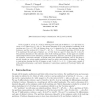Free Online Productivity Tools
i2Speak
i2Symbol
i2OCR
iTex2Img
iWeb2Print
iWeb2Shot
i2Type
iPdf2Split
iPdf2Merge
i2Bopomofo
i2Arabic
i2Style
i2Image
i2PDF
iLatex2Rtf
Sci2ools
ARSCOM
2008
2008
Bounds on the metric and partition dimensions of a graph
Given a graph G, we say S V (G) is resolving if for each pair of distinct u, v V (G) there is a vertex x in S where d(u, x) = d(v, x). The metric dimension of G is the minimum cardinality of all resolving sets. For w V (G), the distance from w to S, denoted d(w, S), is the minimum distance between w and the vertices of S. Given P = {P1, P2, . . . , Pk} an ordered partition of V (G) we say P is resolving if for each pair of distinct u, v V (G) there is a part Pi where d(u, Pi) = d(v, Pi). The partition dimension is the minimum order of all resolving partitions. In this paper we consider relationships between metric dimension, partition dimension, diameter, and other graph parameters. We construct "universal examples" of graphs with given partition dimension, and we use these to provide bounds on various graph parameters based on metric and partition dimensions. We form a construction showing that for all integers and with 3 + 1 there exists a graph G with partition ...
| Added | 08 Dec 2010 |
| Updated | 08 Dec 2010 |
| Type | Journal |
| Year | 2008 |
| Where | ARSCOM |
| Authors | Glenn G. Chappell, John G. Gimbel, Chris Hartman |
Comments (0)

